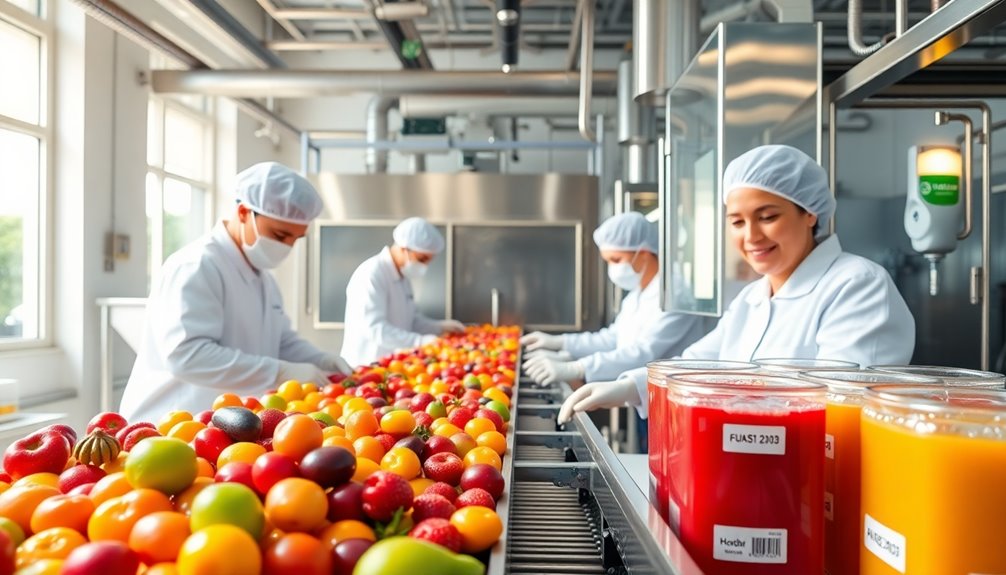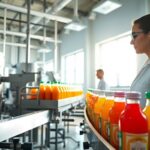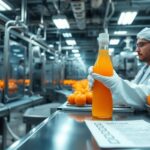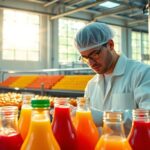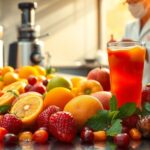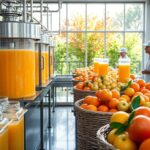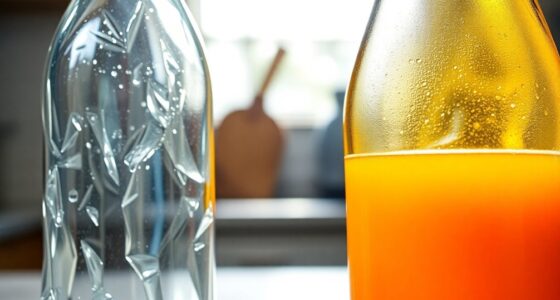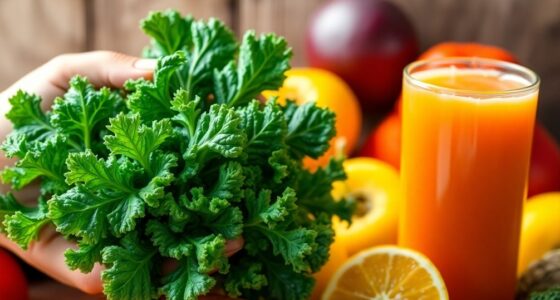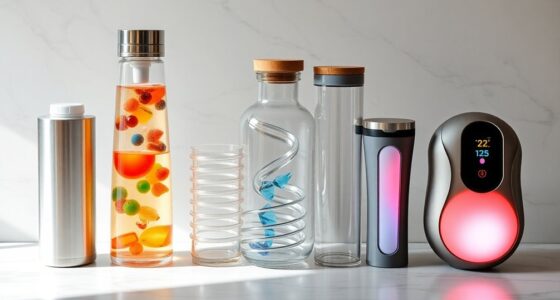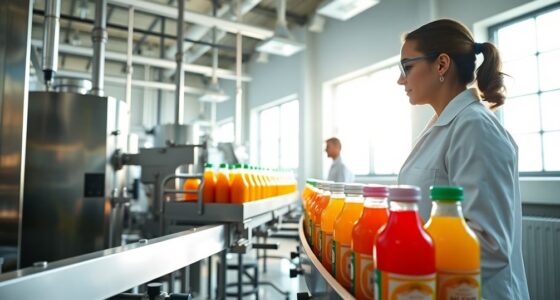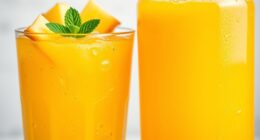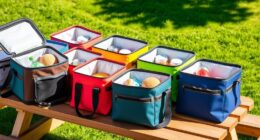In juice production, following health protocols is crucial for ensuring safety and quality. You need to implement a robust HACCP plan that identifies hazards and monitors critical control points. Be vigilant about microbial risks, such as E. coli and patulin, commonly found in fruits. Proper sanitation, temperature control, and routine testing are essential measures. Focusing on these guidelines not only helps meet regulatory standards but also builds consumer trust in your products. Find out more about proactive steps to enhance juice safety! Additionally, it is imperative to stay updated on the latest juice manufacturing health regulations to ensure compliance and safety in your production processes. Regular training sessions for staff on hygiene practices and safety protocols further bolster the effectiveness of your HACCP plan. By prioritizing food safety measures and adhering to these standards, you create a safer product for consumers and a more trustworthy brand reputation in the marketplace.
Key Takeaways
- Implement a robust HACCP plan to identify and control potential hazards in juice production, ensuring food safety.
- Regularly monitor and document critical control points (CCPs) to achieve a 5-log reduction in pathogens as per FDA guidelines.
- Maintain strict sanitation protocols, including employee hygiene and equipment cleaning, to prevent microbial contamination.
- Continuously monitor storage temperatures to keep fresh juice at or below 41°F (5°C) and ensure product quality.
- Conduct routine testing for contaminants, documenting results to ensure compliance with regulatory standards and prevent costly recalls.
The Importance of a Fruit Juice HACCP Plan in Juice Production

When you consider the safety and quality of fruit juice, implementing a HACCP plan is crucial.
A Fruit Juice HACCP Plan helps identify potential hazards like microbial contaminants and mycotoxins during juice production. By adhering to regulatory standards, you guarantee food safety and maintain product integrity.
Effective contamination control through preventive measures greatly reduces risks from pathogens such as E. coli and Salmonella. Monitoring critical points, like raw material reception and post-pasteurization, is essential for managing microbial growth.
Additionally, with over 50% of mango and orange juice samples in Pakistan showing patulin, your HACCP plan directly addresses these quality assurance concerns. Green juice is an example of a product where nutritional value and safety must be prioritized.
Ultimately, it enhances consumer trust and guarantees a safe, high-quality product.
Common Hazards in Juice Production
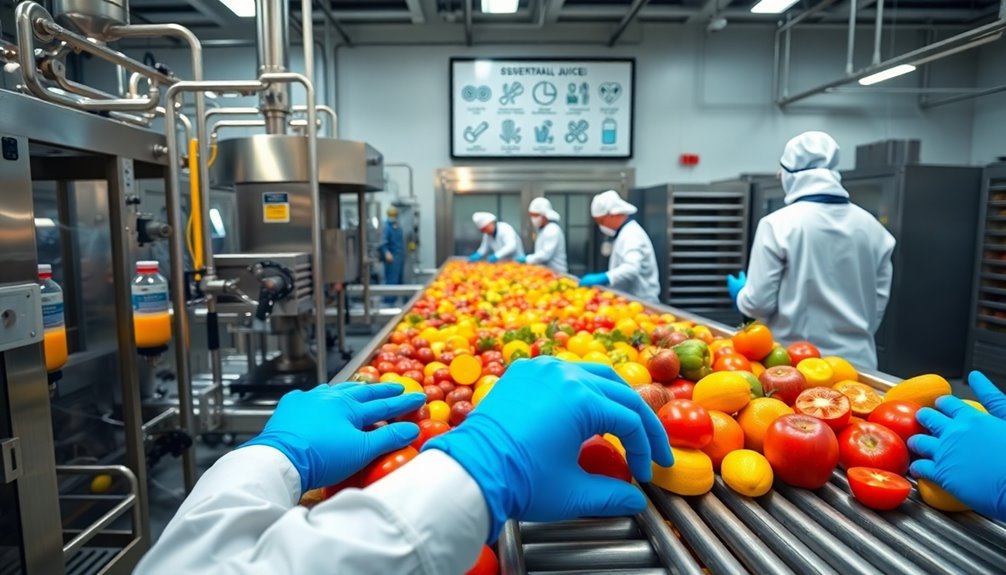
When producing juice, you need to be aware of microbial contamination risks like E. coli and Salmonella, which can survive despite the acidity of the juice.
Additionally, chemical contaminants from pesticides and cleaning agents can compromise safety, making careful sourcing and sanitation practices essential. Incorporating detoxifying juices into your diet can help support overall health and boost immune function, which is vital in preventing illnesses associated with contaminated juices.
Microbial Contamination Risks
Microbial contamination poses serious risks during juice production, as harmful pathogens like E. coli and Salmonella can persist in juice if not effectively managed.
The FDA mandates a 5-log reduction in resistant pathogens, essential for ensuring food safety and greatly reducing outbreak risks. Contamination can occur at various stages, necessitating strict adherence to sampling standards and monitoring of critical control points (CCPs).
Good Agricultural Practices (GAP) play an important role in preventing microbial contamination, protecting both product integrity and consumer health.
Additionally, be aware of patulin, a mycotoxin found in many juice samples, which can exceed regulatory limits.
Chemical Contaminants Concerns
Chemical contaminants can greatly impact juice production, posing serious health risks to consumers if not properly managed. Common issues include pesticide residues and mycotoxins like patulin, which has been detected in over 50% of mango and orange juice samples in Pakistan, often exceeding regulatory limits. To combat these hazards, effective monitoring and preventive measures are essential. Additionally, understanding the risks associated with various cold medications can help ensure consumer safety during juice production and consumption.
| Contaminant Type | Source | Preventive Measures |
|---|---|---|
| Pesticide Residues | Poor agricultural practices | Implement Good Agricultural Practices (GAP) |
| Patulin | Inadequate storage and processing | Continuous testing and monitoring |
| Cleaning Agents | Improper cleaning | Strict adherence to HACCP plans |
Mycotoxins and the Threat of Patulin in Juice Production
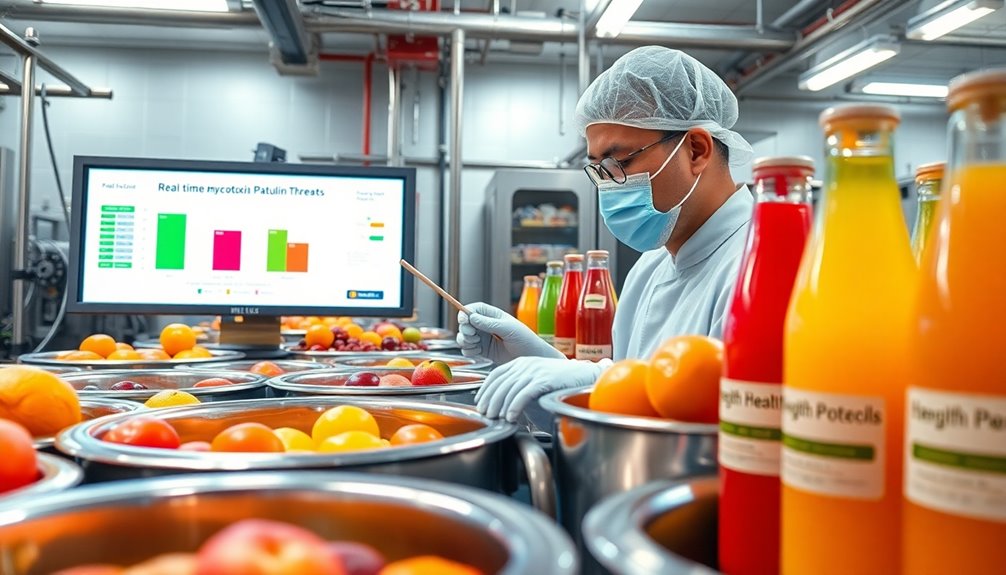
Patulin, a mycotoxin produced by fungi like Penicillium expansum, poses a significant risk in juice production, especially as it can contaminate fruits before they're processed.
In regions like Pakistan, over 50% of mango and orange juice samples tested positive for patulin, with some exceeding the regulatory standard of 50 µg/kg. This contamination presents serious health risks to consumers, making it vital to adhere to regulatory standards.
Implementing a robust HACCP plan is essential to systematically identify and control patulin contamination throughout the juice production process.
Effective preventive measures and strict monitoring protocols must be in place to guarantee consumer safety and mitigate the risks associated with mycotoxins like patulin in juice products.
FDA Juice HACCP Guidance for Microbial Control
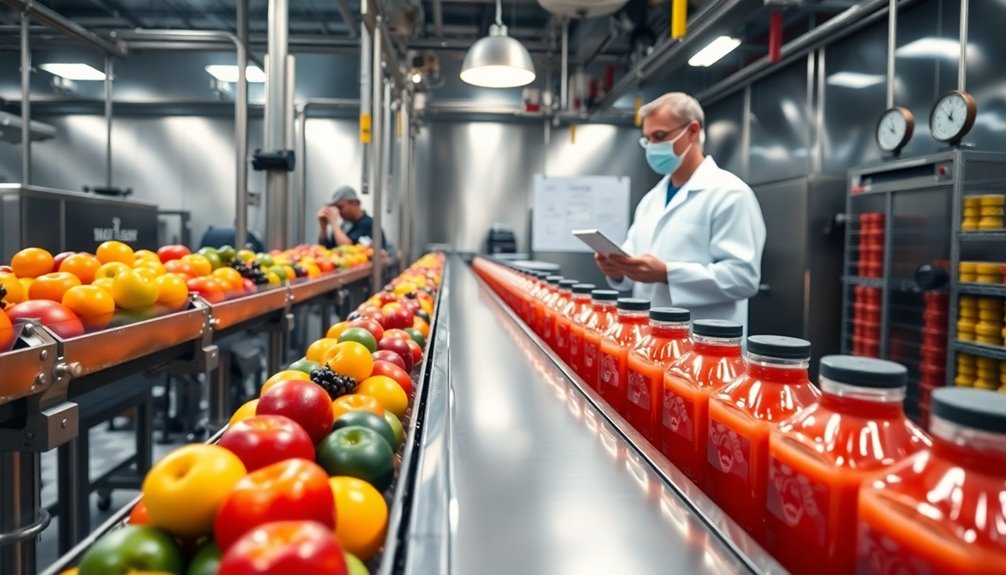
Guaranteeing the safety of juice products goes beyond managing mycotoxin risks like patulin; it also involves a strong focus on microbial hazards.
The FDA juice HACCP regulations require juice processors to implement an HACCP plan that achieves a 5-log reduction in pathogens, markedly reducing the risk of juice-related outbreaks.
With 21 reported outbreaks between 1995 and 2005, effective microbial control is essential.
Your HACCP plan must include routine monitoring and sampling at critical control points (CCPs) to guarantee compliance with safety standards.
Adhering to FDA regulations not only fulfills legal obligations but also maintains consumer trust and product integrity.
Suggested Sampling Points for Microbial Contaminants
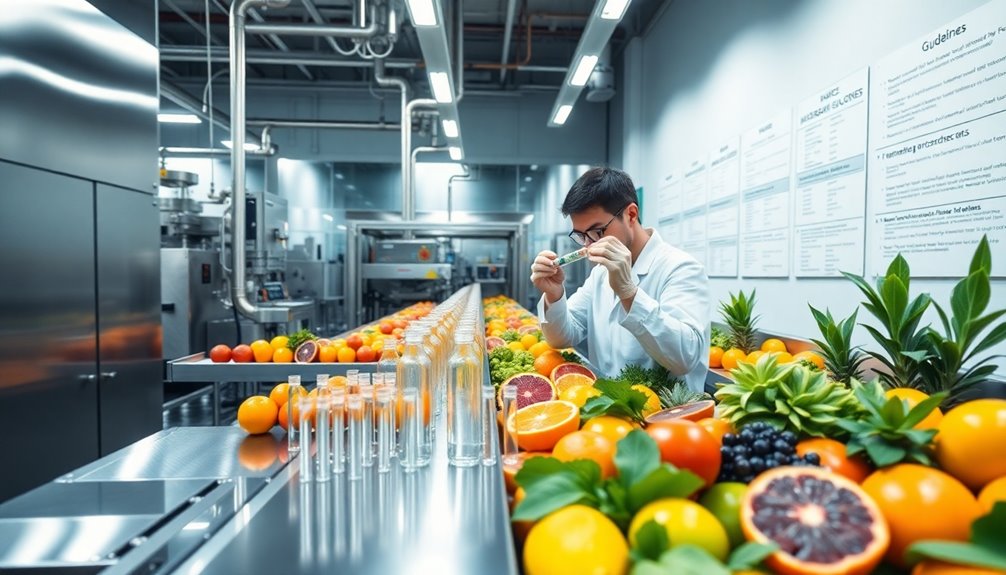
When it comes to ensuring juice safety, you should start sampling at the raw material reception stage to evaluate the microbial load of incoming fruits.
Don't forget to monitor the surfaces of processing equipment regularly, as this helps prevent cross-contamination during production.
These key sampling points are essential for maintaining high safety standards throughout the juice-making process.
Raw Material Testing
To effectively safeguard juice production from microbial contaminants, it's crucial to implement rigorous raw material testing right from the reception stage.
You need to assess incoming fruits for microbial loads to guarantee product safety before processing. Here are key sampling points to take into account:
- Reception Stage: Sample fruits to check for microbial loads immediately upon arrival.
- Post-Pasteurization: Conduct pasteurization monitoring to verify a 5-log reduction in pathogens, adhering to FDA regulations.
- Filling and Packaging: Regularly sample to maintain aseptic conditions and prevent cross-contamination.
- Storage Monitoring: Perform routine sampling during refrigerated storage to control microbial growth.
Equipment Surface Monitoring
While microbial contamination can compromise juice safety, implementing effective equipment surface monitoring is essential for maintaining hygiene throughout the production process.
Routine sampling of processing equipment surfaces, like extraction equipment, conveyor belts, and packaging machines, helps prevent cross-contamination by identifying microbial hazards.
You should conduct surface swab sampling after cleaning to confirm the sanitation effectiveness and adhere to cleanliness protocols.
Establishing a monitoring schedule of at least once per production shift allows you to track contamination trends and improve areas of concern. Additionally, understanding the shelf life of freshly squeezed juices is crucial for ensuring that products remain safe for consumption throughout their intended use.
Preventing Contamination Through Proactive Measures
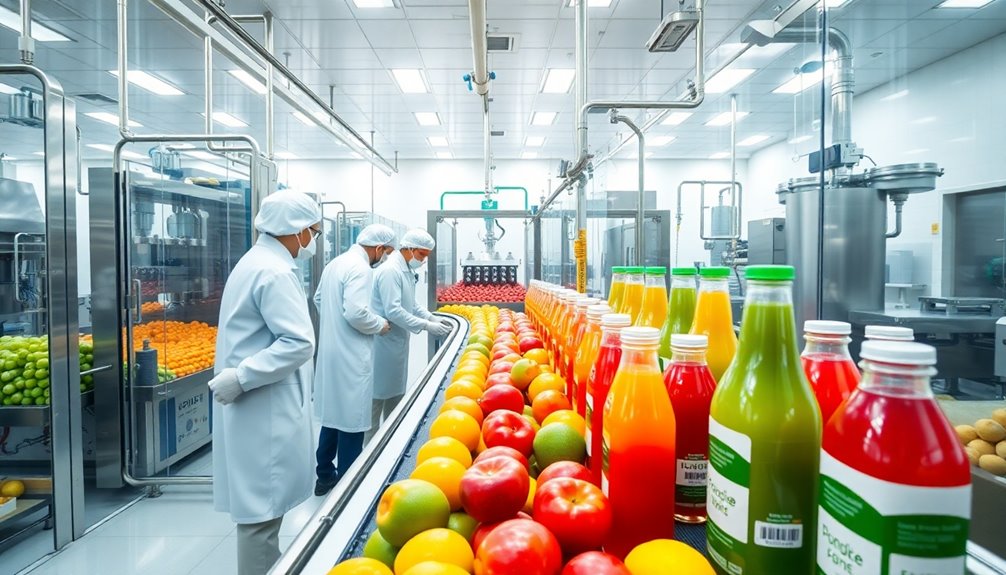
Implementing proactive measures is essential for preventing contamination in juice production. By focusing on specific strategies, you can greatly enhance juice safety.
Here are four key actions to take:
- Develop a robust HACCP plan: Identify and manage potential hazards like E. coli and Salmonella.
- Implement regular sampling strategies: Monitor critical control points (CCPs), such as raw material reception and post-pasteurization, to catch contamination early.
- Maintain strict employee hygiene: Confirm sanitation protocols are followed to avoid introducing pathogens.
- Monitor storage temperatures: Keep fresh juice at or below 41°F (5°C) to prevent microbial growth and maintain quality. Additionally, be aware that shelf life of juices can vary based on storage conditions and exposure.
Maintaining HACCP and Quality Control in Juice Production
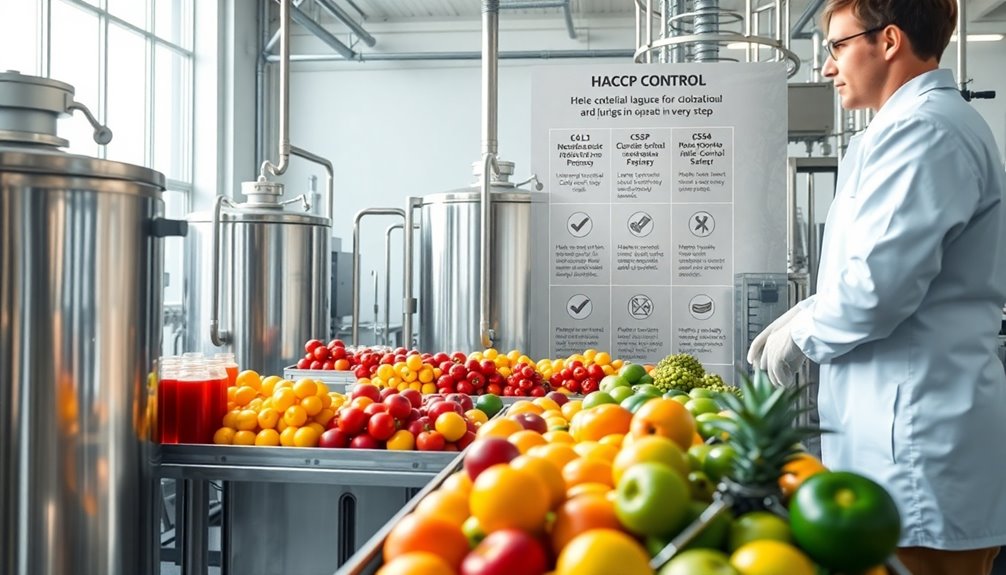
Proactively preventing contamination sets the foundation for maintaining a strong HACCP plan and quality control in juice production.
You need to continuously monitor critical control points (CCPs) to effectively control microbial contamination. Regular aseptic sampling post-pasteurization is vital to verify a 5-log reduction of pathogens, guaranteeing consumer safety as required by FDA regulations.
Utilizing beverage testing equipment, like QualiTrus systems, provides real-time data to monitor potential contaminants. Documenting temperature checks and employee hygiene practices is essential for HACCP compliance, preserving the integrity of your juice production.
By implementing rigorous testing protocols, you enhance risk management, safeguarding consumer health and preventing costly recalls associated with contaminated products.
Prioritizing these steps guarantees your production process meets regulatory compliance and quality control standards.
Frequently Asked Questions
What Safety Measures Were Required to Prepare Safe Juice?
To prepare safe juice, you need to implement several safety measures.
Make certain to source raw fruits from approved suppliers and inspect them upon arrival.
Maintain strict personal hygiene while handling produce, and keep food contact surfaces clean and sanitized.
Store fresh juice at or below 41°F (5°C) after extraction, and provide clear storage instructions on packaging.
Finally, monitor critical control points continuously to guarantee microbial control throughout the juice production process.
Which of the Following Regulations Specify HACCP Requirements for Juice Processing?
Did you know there were 21 reported juice-related outbreaks between 1995 and 2005?
To guarantee safety, the FDA juice HACCP regulation mandates that all juice processors, except retail establishments, implement a HACCP plan.
This plan requires achieving a 5-log reduction in resistant pathogens, greatly minimizing the risk of outbreaks.
What Is the 5 Log Reduction Statement?
The 5-log reduction statement means you need to reduce harmful pathogens in juice by 99.999%.
If you start with 100,000 pathogens, your processing must bring that down to just 1 or fewer. Achieving this reduction is essential for safety and compliance with FDA regulations.
You can use methods like pasteurization to effectively kill these microorganisms, ensuring your juice is safe for consumers and maintaining trust in your product.
Does the FDA Regulate Fruit?
Yes, the FDA does regulate fruit to guarantee it's safe for consumption.
You should know that the agency enforces guidelines to minimize contamination risks, requiring adherence to Good Agricultural Practices.
The FDA also monitors pesticide residues and sets tolerance levels to protect you.
Additionally, they enforce labeling requirements so you can trust the information about the fruit you buy.
These regulations help maintain high safety standards in the food supply.
Conclusion
In juice production, following health protocols isn't just a guideline—it's your recipe for success. By implementing an effective HACCP plan, you can tackle hazards head-on and keep your juice safe and delicious. Remember, a proactive approach to contamination prevention is like adding a splash of sunshine to your process, brightening your product's quality. Stay vigilant, adhere to FDA guidance, and keep your juice flowing with confidence. Your customers deserve nothing less than the best!
Cindy thoroughly researches juicing trends, techniques, and recipes to provide readers with practical advice and inspiration. Her writing style is accessible, engaging, and designed to make complex concepts easy to understand. Cindy’s dedication to promoting the advantages of juicing shines through her work, empowering readers to make positive changes in their lives through the simple act of juicing.

